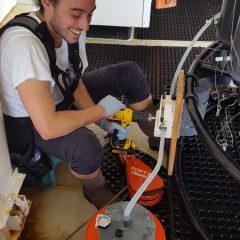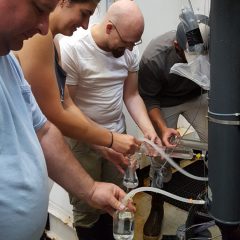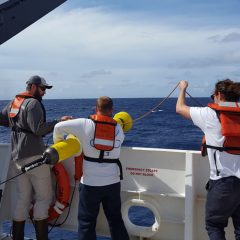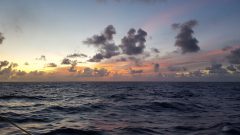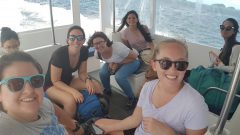Photo Gallery Story
Originally published on the GOSHIP I07 Blog. Author: Holly Westbrook.
Hello! My name is Holly and I am a scientist. When you read the word “scientist” you might imagine a person in a white lab coat, goggles, and gloves, swirling a flask of strange colored liquid, or maybe frowning at a clipboard. Now, sometimes science does look like that, but other times it looks like this [images shown].
The scientists onboard the Ronald H. Brown are “oceanographers,” scientists who study the ocean. It can be a tricky field to study because we have to collect samples from places that can’t be easily reached (for example, the middle of the Indian Ocean).
We collect water samples from the bottom of the ocean all the way up to the top using a piece of equipment called a “rosette.” The rosette has many different things attached to it, to bring up water we use “Niskin bottles.” Once the rosette is on deck and secured we can start sampling. There are many different people who need to get water samples. We have a specific order of who goes when to make sure things stay organized and all the time-sensitive samples are collected quickly. Still, things can get a little crowded.
There are a couple of different ways to collect water, many of us use plastic tubes and glass bottles, some use plastic bottles, some use glass syringes, and one person has a bit more of an involved method:
A lot of the scientists work 12 hour shifts, we usually have another person who will take over our shift when we are done. That means that no matter the time of day there is always research being done! My shift is from 11:30 pm to 11:30 am. It was a little rough adjusting at first, but by now I’ve gotten used to it. Plus I’ve seen some pretty great sunrises.
When we’re not working, how we use our time is up to us. We can read outside, watch movies in the lounge, play card games, go to the gym, or talk to friends online—there’s a surprising number of ways to occupy your time!
Breakfast, lunch, and dinner are prepared by the stewards and they are at the same time every day. But there is always something to eat, which is good because I sleep through dinner and wake up several hours before breakfast. There’s things like oatmeal and cereal, but also daily snacks and ice cream at any time.
The days can be repetitive and tend to blend together but the importance of the work and the company we keep makes it all worthwhile!
Image Captions
From Left:
- Christian sampling black carbon, looks like a pretty involved process. Photo Credit: NOAA.
- From left to right, Chuck, Leah, CFCs Chuck, and Ian working in close quarters to get their water samples. Photo Credit: NOAA.
- From left to right, Ian, Andy, and Christian deploying an ARGO float. Photo Credit: NOAA.
- A beautiful sunrise I got to see while waiting for my turn at the rosette. Photo Credit: NOAA.
- From left to right: Bonnie, Holly Westbrook, Amanda, Catherine, Carmen, Annelise, and Jenna on a water taxi to Mahé. Photo Credit: NOAA.

